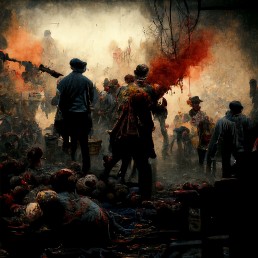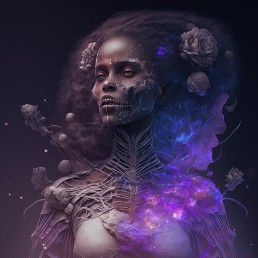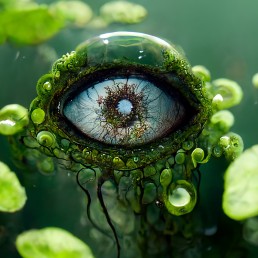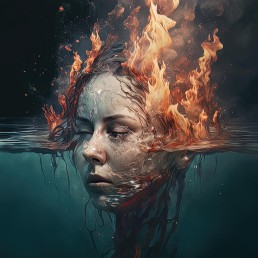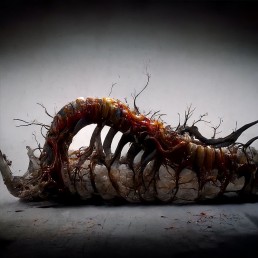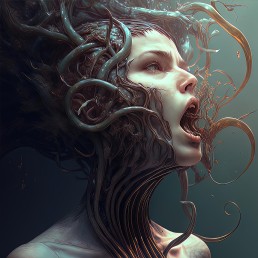"Generate" instead of "create"- Interview with Ian "Poisoner" Andrews about artificial intelligence in art
Is AI in art evil? For us? Have we let a genie out of the bottle, perfecting itself more and more with every one of the millions of clicks it gets every day? It is difficult to say where this will end, but one can assume that the abilities of an "artificial intelligence", due to its much higher pool of material, will eventually overtake the ability of humans for creativity! In terms of speed, this has already happened.
We talked to someone who should know: American artist Ian "Poisoner" Andrews is a master of the art of engaging with an AI trained to create art. Let's just follow him...
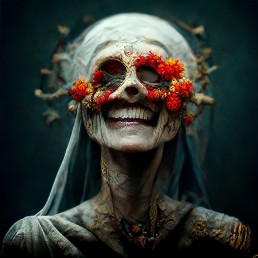
I think many art lovers do not (yet) know what “MidJourney” or “Prompts” are. Please explain how your art is created from a purely technical point of view.
“I’ve been an artist in various forms over the years, including an amateur writer. The Prompts are the language used to essentially tell the AI, in this case Midjourney, what the parameters are for the generation. Prompts are composed of three sections. A main theme, the first section of the prompt sequence; secondary details like setting, atmosphere, type of image (photograph versus oil painting, for example); and the third section of the prompt is all the tweaks, like Finely Detailed, or Photo taken by Sony. These are the embellishments. It’s about understanding how the AI interprets key words and phrases, and it creates weights or priorities to these words based largely on if they appear earlier or later in the prompt.”
You could almost say that the real “art” in this kind of artistic implementation is the definition of an idea and no longer the craftsmanship of this idea. Since AI makes it possible to create any motif in any imaginable style: How concrete is your idea before you start? Or do you also work with the possibility of how the AI deals with your idea?
“I almost look at myself and my relationship to the AI as being a director working with an actor. The AI is the artist, but I am the one telling the story through the prompt. I have a specific style that I lean towards, mainly fantasy type art, but the idea isn’t always completely formed. I may start with a prompt that says “Female Assassin in tactical gear” and then see what comes out the other side. If there are other elements that come to mind during this process, I will copy the prompt and add until I land on something that I like. I do think I have learned through experience how to get the AI to produce a certain result in terms of style, but there are still things that happen for unknown reasons. I was trying to generate an image of a dark elf laying on a bed, and it was giving me just a normal image of a normal woman laying her head on a pillow”
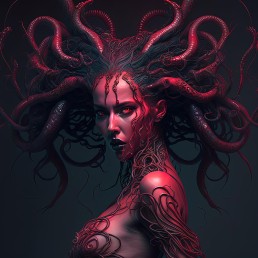
You can find it frightening or fascinating: How do you see AI’s performance in this process? Is it a purely technical matter of computing power and programming or are we entering areas where we admire the result of the machine even though we can no longer understand exactly how it came to this result (called a “black box” in technical language)? The disturbing mystery of an artificial intelligence….
“I can see both sides, but I favor the more optimistic view. There are some phrases I use in my prompts that I have no clue what actual affect it has on the overall image. This comes from the early days of copying other people’s prompts in the event that had a good looking generation. But as time has gone on and AI has improved so much in such a short time, less words will be needed to generate even more amazing results. Even now that Midjourney has entered into its fourth version, with a fifth just a few short months away, it’s already creating results far superior to even the most accomplished artists. But words will still be needed, and people who understand how the AI communicates will always produce better results than those who don’t. I see it all the time on DeviantArt, my online art community. There is plenty of AI garbage being churned out at an impressive speed. I always try to generate quality over quantity.”
As long as “Ai art” is labeled as such, the viewer can decide for himself whether he wants to look only at the idea or at the idea AND the craftsmanship of the artist. If these markings are missing, it becomes difficult in my eyes. Isn’t that a kind of fraud?
“I have been in this conversation many times. I understand why traditional artists are annoyed or even pissed that it is now easier for a layperson to sit down in front of their computer, type a few words, and end up with an amazing piece of art. You’ll noticed I’ve used the term ‘generate’ instead of ‘create’. I don’t view myself as the creator of these works. I add my edits and special touches through Photoshop and various other programs, but by and large, I didn’t create the piece. And I feel for the artists who have had their work be the foundation for training the AI. I won’t go as far to say that it is a copyright issue. If you think about it, all art is derivative. We all get inspiration from other people, and we tend to adopt what we like into our own work. Some of my earlier traditional art when I was younger was heavily influenced by H.R. Giger, although I have no where near the talent he had. So in that sense, the AI never copies an artist, it merely emulates and produces an unique piece in the style of said artist. I personally do not reference any artists in my prompt because it does feel like cheating, but I know a lot of people who don’t have such reservations.”
Finally, a look into the future: this way of creating art (and in my opinion it is!) is very new and its development is certainly not yet at its end. Where do you see future dangers, what will revolutionize art and our view of it?
“Not to sound cliché but the cat is out of the bag when it comes to AI art. There is no putting it back. On the one hand, this has made the act of creation itself so much more accessible to so many people who may not have had the same creative outlet. People with disabilities are able to express themselves in newer ways. And it’s only going to continue to get better over time. Art will be more accessible to the average person, and great artists will still be in demand because AI is far from perfect. As for the future, I know that deepfakes are a real issue in many cases. Pornography, love it or hate it, will be much easier to create. Many working traditional artists will need to adapt to survive. But like all advancements in technology, the industry will adjust and change. New opportunities will present themselves. Since I have been generating AI art, I have created an album cover for an established music group, I’ve been commissioned to create works of art using photographs, I’ve been commissioned to help with a board game. And I was asked to be a part of your publication. None of these things would have happened had it not been for my involvement in AI art generation. I think this shifts the meaning of ‘art’ to something that was once only attainable by the few, to something that is achievable by the many.”
Ian “Poisoner” Andrews Website: Deviant Art
AI recourses for art:
MidJourney
Dall-E 2
Stable Diffusion
Or if you want to start right away: https://huggingface.co/spaces/stabilityai/stable-diffusion
Thanks for the interview. If someone would ask the questioner for his opinion… In my mind, looking at the pure creative output of high quality art, AI is an asset to art. Many people who have great artistic visions and ideas now have a tool to implement them. What otherwise would not have been possible due to a lack of craftsmanship. The more people on this planet who create art, the better off we are. However, if at some point the Chinese (or whoever from our political alpha plague) hacks the internet and destroys it, then AI is dead. And we will have forgotten the craft of painting pictures….
